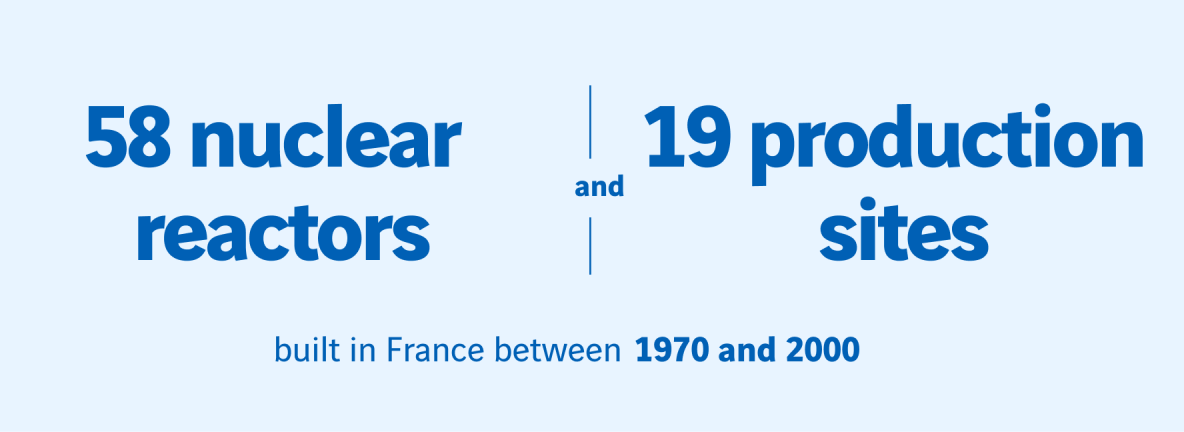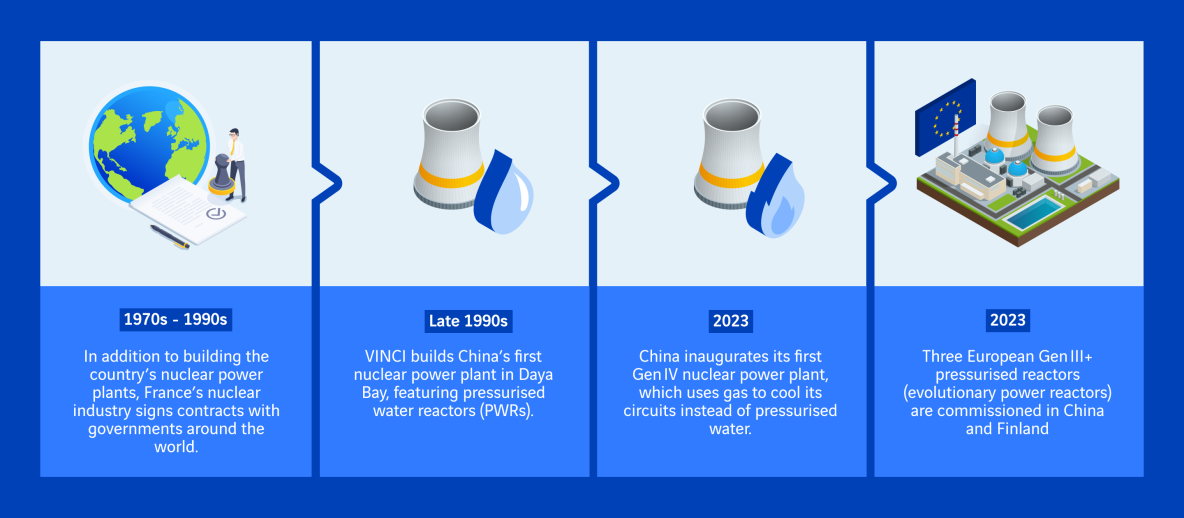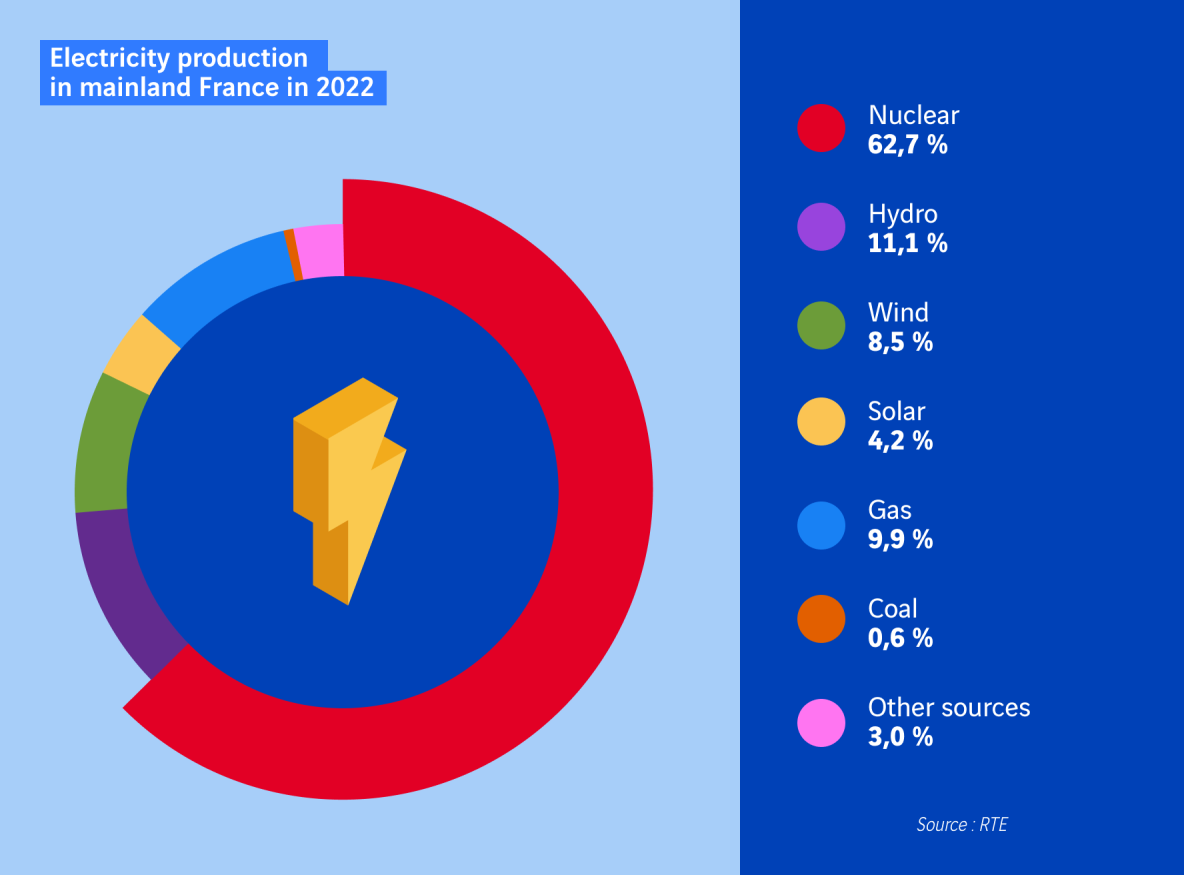
France, the land of nuclear power
France is the second-largest producer of nuclear power in the world with 58 reactors. Read on for a look back at the country’s unique legacy in the energy sector, from the major expansion in nuclear capacity in the 1970s to the Flamanville EPR.
On the same focus
Fusion: the energy creating high hopes
Fission: the historical nuclear energy
Challenges and discussions about nuclear power
1973 : the trigger and the adoption of nuclear power
In 1973, the oil crisis sent shockwaves across the world’s markets. The incident came as a cold shower for all those nations that had focused on oil to produce their electricity. Japan and France were two such countries. Nuclear power had been proven to be an effective and reliable energy source, so it appeared to offer an escape route out of the crisis, especially since France had already begun investing in nuclear power after the Second World War. The Messmer plan was launched, which took its name from the then Prime Minister. The plan was designed to secure France’s energy independence. Between the 1970s and the turn of the 2000s, France built 58 nuclear reactors across 19 production sites, 80% of which were constructed by VINCI Group companies. Today, thousands of employees are busy every day working for EDF and other major clients, such as the French Alternative Energies and Atomic Energy Commission (CEA), Orano (formerly Areva) and the Ministry for the Armed Forces.
International attraction for France's nuclear expertise
French industrial companies have made pressurised water reactors (PWRs) their speciality. This expertise has given them a gateway to the international market. Whether South Africa, South Korea or China, countries are clamouring to leverage such expertise, and France is helping grow the world’s nuclear industry. At the end of the 1990s, VINCI took part in building China’s first nuclear power plant in Daya Bay on the shores of the South China Sea. Ever since, China has been significantly scaling up its nuclear capacity. In an effort to reduce its dependence on foreign technologies and lead the race to pioneer the reactors of the future, China commissioned the first Gen IV reactor in 2023, which uses gas to cool the circuits instead of pressurised water. Competition in the international arena is prompting European industry to close ranks. In addition to fostering greater cooperation, EDF’s initiative played a key role in developing the Gen III EPR (European Pressurised Reactor), which is designed to renew the existing fleet of nuclear power plants. In 2023, three of the EPRs were commissioned in China and Finland. The Flamanville EPR in France is expected to come online in 2024.
France's distinctive energy mix
France cuts a somewhat distinctive figure in the international energy scene. In the 1990s and 2000s, three quarters of the country’s electricity was generated from nuclear power. In 2019, that percentage was still 71%, which is the highest in the world. Today, nuclear power continues to be the main source of electricity in France, but its dominance is tending to wane as new renewable energies gain traction, led by wind and solar power. Hydropower consistently holds second place. In the country’s energy mix, nuclear power offers sound foundations for improving France’s ability to withstand crises and unforeseen incidents. In 2023, the country even claimed back its title as the leading exporter of electricity in Europe.
Nuclear, hydro, wind, coal... you can see the composition of France's energy mix in real time!
Nuclear power back on the agenda
In 2022, the President of the Republic announced the government’s plans to revive the country’s nuclear programme by building six Gen II EPR reactors (EPR2), with the option of building a further eight reactors. The first reactor is due to be commissioned in 2035. The challenge of reinforcing energy sovereignty in light of the situation in Ukraine and the need to decarbonise the economy in response to the climate emergency extend beyond national borders and have cast nuclear energy in a new light around the world.
I’ve been working in the sector for 30 years and I’ve never known a more conducive period with so many development prospects and such dynamic growth in the international market.
For Bruno Lancia, CEO of VINCI Construction subsidiary Nuvia Construction
Most viewed
Vous aimerez aussi
Words from researchers: let's fight stereotypes!
Charlotte, a research fellow at École des Mines, and Erwan, a university professor and researcher at AgroParisTech, talk…
Fondation VINCI pour la Cité: opening the door to others is another way of reaching out!
With some 1.3 million organisations and 2 million employees, France can lay claim to a dynamic network of associations…
Sea water desalination: a solution for turning the tide on the water scarcity crisis?
As water shortages continue causing havoc in a growing number of regions around the world, an age-old idea is experiencing a…





